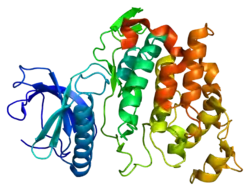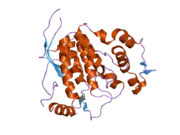CLK3 (gene)
Dual specificity protein kinase CLK3 is an enzyme that in humans is encoded by the CLK3 gene.[5][6] The CLK3 gene encodes a serine/threonine type protein kinase with a non-conserved N-terminal domain. A long and short isoform (phclk3 and pclk3/152) result from alternative splicing and coexist in different tissues. Isoform phclk3/152 lacks the kinase domain.[7]
References
- GRCh38: Ensembl release 89: ENSG00000179335 - Ensembl, May 2017
- GRCm38: Ensembl release 89: ENSMUSG00000032316 - Ensembl, May 2017
- "Human PubMed Reference:". National Center for Biotechnology Information, U.S. National Library of Medicine.
- "Mouse PubMed Reference:". National Center for Biotechnology Information, U.S. National Library of Medicine.
- Hanes J, von der Kammer H, Klaudiny J, Scheit KH (Jan 1995). "Characterization by cDNA cloning of two new human protein kinases. Evidence by sequence comparison of a new family of mammalian protein kinases". J Mol Biol. 244 (5): 665–72. doi:10.1006/jmbi.1994.1763. PMID 7990150.
- Talmadge CB, Finkernagel S, Sumegi J, Sciorra L, Rabinow L (Dec 1998). "Chromosomal mapping of three human LAMMER protein-kinase-encoding genes". Hum Genet. 103 (4): 523–4. doi:10.1007/s004390050861. PMID 9856501.
- "Entrez Gene: CLK3 CDC-like kinase 3".
Further reading
- Maruyama K, Sugano S (1994). "Oligo-capping: a simple method to replace the cap structure of eukaryotic mRNAs with oligoribonucleotides". Gene. 138 (1–2): 171–4. doi:10.1016/0378-1119(94)90802-8. PMID 8125298.
- Suzuki Y, Yoshitomo-Nakagawa K, Maruyama K, et al. (1997). "Construction and characterization of a full length-enriched and a 5'-end-enriched cDNA library". Gene. 200 (1–2): 149–56. doi:10.1016/S0378-1119(97)00411-3. PMID 9373149.
- Duncan PI, Stojdl DF, Marius RM, et al. (1998). "The Clk2 and Clk3 dual-specificity protein kinases regulate the intranuclear distribution of SR proteins and influence pre-mRNA splicing". Exp. Cell Res. 241 (2): 300–8. doi:10.1006/excr.1998.4083. PMID 9637771.
- Strausberg RL, Feingold EA, Grouse LH, et al. (2003). "Generation and initial analysis of more than 15,000 full-length human and mouse cDNA sequences". Proc. Natl. Acad. Sci. U.S.A. 99 (26): 16899–903. doi:10.1073/pnas.242603899. PMC 139241. PMID 12477932.
- Ota T, Suzuki Y, Nishikawa T, et al. (2004). "Complete sequencing and characterization of 21,243 full-length human cDNAs". Nat. Genet. 36 (1): 40–5. doi:10.1038/ng1285. PMID 14702039.
- Hillman RT, Green RE, Brenner SE (2005). "An unappreciated role for RNA surveillance". Genome Biol. 5 (2): R8. doi:10.1186/gb-2004-5-2-r8. PMC 395752. PMID 14759258.
- Jin J, Smith FD, Stark C, et al. (2004). "Proteomic, functional, and domain-based analysis of in vivo 14-3-3 binding proteins involved in cytoskeletal regulation and cellular organization". Curr. Biol. 14 (16): 1436–50. doi:10.1016/j.cub.2004.07.051. PMID 15324660.
- Gerhard DS, Wagner L, Feingold EA, et al. (2004). "The Status, Quality, and Expansion of the NIH Full-Length cDNA Project: The Mammalian Gene Collection (MGC)". Genome Res. 14 (10B): 2121–7. doi:10.1101/gr.2596504. PMC 528928. PMID 15489334.
- Rual JF, Venkatesan K, Hao T, et al. (2005). "Towards a proteome-scale map of the human protein-protein interaction network". Nature. 437 (7062): 1173–8. doi:10.1038/nature04209. PMID 16189514.
- Olsen JV, Blagoev B, Gnad F, et al. (2006). "Global, in vivo, and site-specific phosphorylation dynamics in signaling networks". Cell. 127 (3): 635–48. doi:10.1016/j.cell.2006.09.026. PMID 17081983.
- Wissing J, Jänsch L, Nimtz M, et al. (2007). "Proteomics analysis of protein kinases by target class-selective prefractionation and tandem mass spectrometry". Mol. Cell. Proteomics. 6 (3): 537–47. doi:10.1074/mcp.T600062-MCP200. PMID 17192257.
External links
- Clk dual-specificity kinases at the US National Library of Medicine Medical Subject Headings (MeSH)
- Human CLK3 genome location and CLK3 gene details page in the UCSC Genome Browser.
This article is issued from Wikipedia. The text is licensed under Creative Commons - Attribution - Sharealike. Additional terms may apply for the media files.






